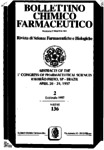Por favor, use este identificador para citar o enlazar este ítem:
http://www.alice.cnptia.embrapa.br/alice/handle/doc/12762Registro completo de metadatos
| Campo DC | Valor | Lengua/Idioma |
|---|---|---|
| dc.contributor.author | DREOSSI, S. A. C. | pt_BR |
| dc.contributor.author | LANCHOTE, V. L. | pt_BR |
| dc.contributor.author | SANTOS, N. A. G. | pt_BR |
| dc.contributor.author | CERDEIRA, A. L. | pt_BR |
| dc.contributor.author | GOMES, M. A. F. | pt_BR |
| dc.contributor.author | CARVALHO, D. | pt_BR |
| dc.contributor.author | BONATO, P. S. | pt_BR |
| dc.date.accessioned | 2015-11-06T03:01:15Z | - |
| dc.date.available | 2015-11-06T03:01:15Z | - |
| dc.date.created | 1997-11-29 | pt_BR |
| dc.date.issued | 1997 | pt_BR |
| dc.identifier.citation | In: CONGRESS OF PHARMACEUTICAL SCIENCES, 1., 1997, Ribeirao Preto, SP. Bollettino Chimico Farmaceutico,v. 136, p.132, 1997. Abstract. | pt_BR |
| dc.identifier.uri | http://www.alice.cnptia.embrapa.br/alice/handle/doc/12762 | pt_BR |
| dc.description | Substituted phenylureas are selective herbicides used extensively in agriculture and are fairly persistent in the aquatic environment. This has led to the development of many analytical procedures based on high performance liquid cromatography or gas chromatography for determining phenylurea residues in aqueous samples. Although HPLC methods have the advantage of requiring no derivatization, gas chromatography methods seem to be more convenient when coupled to the mass espectrometer detector by providing the reliable of the presence of the herbicide. This technique was employed in the present study to investigate the presence of tebuthiuron residues in 40 aqueous environmental samples collected over a period of ten months (10/95 to 07/96) from the Espraido watershed, Ribeirao Preto, SP, Brazil. The procedure was based on the extraction of water samples (100 ml) with 12 ml of the extraction mixture consisting of dichloromethane: iso propanol (9:1, v/v), after addition of 25 ul of the internal standard solution (caffeine, 5 ug/ml) and alkalinization with 25 ul of 4 M NaOH. After mechanic shaking for 1 hour, 6 ml of the organic phases were separeted and evaporated to dryness under an air flow, at ambient temperature. The residues obtained were dissolved in 1 ml toluene and than, 100 ul of acetic anhydride was added. The mixture was heated for 2 h at 170oC. After cooling, the mixture was again evaporated to dryness and the residue was dissolved in 25 ul of acetone for gas chromatography analysis using a GC-MS QP5000 Shimadzu apparatus. The derivatives of tebuthiuron and caffeine were separated on a DB-5 column (J&W Scientific, 0,25 mmx30m, film of 0,25 um) using the following oven temperature program: start at 60oC for 1 min, increase to 150oC with a rate of 20oC/min and then to 240oC with a rate of 10oC/min; helium was used as carrier gas. The mass spectrometry detector was operated in the single ion monitoring mode at the temperature of 230oC. The ions selected for specific detection were 171 and 156 for the tebuthiuron derivative and 194 and 109 for caffeine. Under the chromatographic conditions selected and by extracting 100 ml of water samples, the quantification limit was estimated to be 0.02 ug/l. Tebuthiuron was not detected in the samples analyzed using the procedure described above. | pt_BR |
| dc.language.iso | eng | eng |
| dc.rights | openAccess | eng |
| dc.subject | GC-MS | pt_BR |
| dc.title | GC-MS method for the determination of tebuthiuron in water. | pt_BR |
| dc.type | Resumo em anais e proceedings | pt_BR |
| dc.date.updated | 2015-11-06T03:01:15Z | pt_BR |
| dc.subject.nalthesaurus | tebuthiuron | pt_BR |
| riaa.ainfo.id | 12762 | pt_BR |
| riaa.ainfo.lastupdate | 2015-11-05 | pt_BR |
| dc.contributor.institution | USP; USP; USP; ANTONIO LUIZ CERDEIRA, CNPMA; MARCO ANTONIO FERREIRA GOMES, CNPMA; USP; USP. | pt_BR |
| Aparece en las colecciones: | Artigo em periódico indexado (CNPMA)  | |
Ficheros en este ítem:
| Fichero | Descripción | Tamaño | Formato | |
|---|---|---|---|---|
| 1997RAs008.PDF | 80,36 kB | Adobe PDF |  Visualizar/Abrir |









